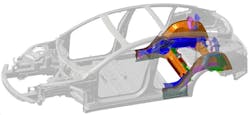Although die-cast aluminum automotive body parts are not new, Tesla has employed the process in what some have termed “mega castings,” with even larger scale application of the forming process to come. Its Model Y small SUV, which began production in its Fremont, Calif., assembly plant in spring 2020, is based on the Model 3 sedan and shares about 75 percent of its parts.
But in a change from the Model 3, the Model Y introduced two large die-cast aluminum rear body pieces for the inner wheelhouse, frame rails, and strut towers, joined in the center with a bonded/bolted bracket. These large diecast pieces are formed with a high-pressure press and replace about 70 stampings, extrusions, and castings for the same parts in the Model 3.
And in an October 7 tweet on Twitter, co-founder and CEO Elon Musk gave additional details of big changes promised for the structure and battery pack of the Model Y produced in Tesla’s Gigafactory Berlin, which is scheduled to open in 2021, with its first Model Y expected to roll out before the end of next year.
“Berlin will use 4680 cell with structural battery pack & front & rear single piece castings,” he tweeted. “Also, a new paint system. Lot of new technology will happen in Berlin, which means significant production risk. Fremont & Shanghai [the company’s other assembly plant] will transition in approximately two years when new tech is proven.”
Musk described the rear structure of the Model 3 as a “patchwork quilt” that required complex forming and assembly in the factory’s body shop. In comparison, the 410-ton “Giga Press” required to make the new single-piece castings is 64 feet long and 17 feet tall, but Musk said in an April “Third Row Tesla Podcast” the size of the factory’s body shop could be reduced by 30 percent with such large-scale castings, while the cost of labor could be reduced by 20 percent. The changes could be implemented on the Model 3 as well.
What is less known is the repairability of the vehicle with such large castings, which would logically need to be replaced if they are damaged in a collision. Musk did promise in the October Twitter exchange that “the crash-absorption rails can be cut off and replaced with a bolted-on part for collision repair.”
‘Battery Day’ and Munro give details of structural battery pack
At Tesla’s “Battery Day” event following its annual shareholders’ meeting, Musk teased some details of the new structural battery pack, which he predicted would be how all new EVs would be produced in the future. Using flame-retardant structural adhesive, cells will be adhered to top and bottom aluminum sheets for rigidity. Most center body parts will be eliminated.“It’s a revolution in battery and body engineering,” Musk said. “This gives incredible stiffness — this is actually better than what aircraft do, because aircraft use fuel, which is liquid.”
The “4680 cell” refers to the size of the individual cells that make up the battery pack: 46 mm in diameter, and 80 mm in length, which replace the current “2170” cells, which are 21 mm in diameter and 70 mm in length. (For size comparison, a AA cell is approximately 14 mm in diameter and 50 mm long; a D cell is about 33 mm in diameter and 61.5 mm long.)
Engineering consultant Munro & Associates in Auburn Hills, Mich., disassembles new cars and trucks — down to the last nut, bolt, and clip — to provide engineering and manufacturing advice and cost analysis to OEM engineers. The firm tore down the Model Y, and CEO Sandy Munro walks viewers through its attributes in a YouTube series. In a separate video, Munro shows a mockup of how his team thinks the new battery pack will be configured.
“No one knows precisely what’s going on with the Tesla battery pack that’s coming down the pike,” he said. “What we can tell you is that the battery pack with this type of cell is going to be six times the power; it’s going to have five times more energy, and it’s going to increase the range by about 16 percent. The better part is that this arrangement is probably going to be around half the cost of the old pack due to design improvements.”
About the Author
Jay Sicht
Editor-in-Chief, FenderBender and ABRN
Jay Sicht is editor-in-chief of FenderBender and ABRN. He has worked in the automotive aftermarket for more than 29 years, including in a number of sales and technical support roles in paint/parts distribution and service/repair. He has a bachelor's degree in journalism from the University of Central Missouri with a minor in aviation, and as a writer and editor, he has covered all segments of the automotive aftermarket for more than 20 of those years, including formerly serving as editor-in-chief of Motor Age and Aftermarket Business World. Connect with him on LinkedIn.
Don't miss Jay's next article or podcast. Sign up for FenderBender Today's Collision Repair News and ABRN eNews here.

